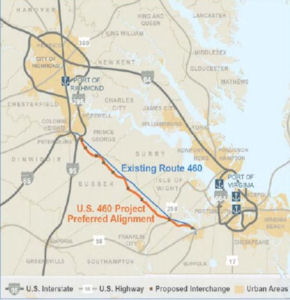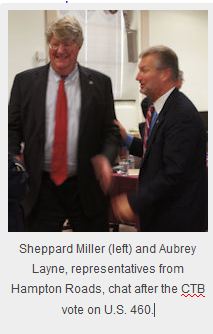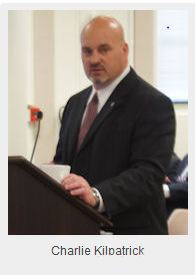About Bacon’s Rebellion
Bacon's Rebellion is Virginia's leading independent portal for news, opinions and analysis about state, regional and local public policy. Read more about us here.
CTB Advances $1.4 Billion U.S. 460 Project
 With a new financing plan, the interstate-grade U.S. 460 Connector is a go, as the McDonnell administration touts the highway's economic development potential.
With a new financing plan, the interstate-grade U.S. 460 Connector is a go, as the McDonnell administration touts the highway's economic development potential.
by James A. Bacon
The Commonwealth Transportation Board approved Wednesday the issuance of up to $425 million in tax-free bonds to finance construction of the U.S. 460 Connector between Petersburg and Suffolk in one of the priciest economic development initiatives in Virginia history.
The state will contribute roughly 80% of the cost of the $1.4 billion project with funds funneled through the Virginia Department of Transportation (VDOT) and the Virginia Port Authority. Bonds, to be supported by toll revenues, will pay for the balance of the 55-mile, Interstate-grade highway, which is designed to bolster the competitive position of Virginia's ports and attract large industrial and logistical investments to the U.S. 460 corridor.
Most of Virginia's transportation mega-projects address a congestion crisis, but U.S. 460 represents an opportunity, Aubrey L. Layne, the Hampton Roads district representative, told fellow CTB members. Layne, who has worked behind the scenes for years to bring the project to fruition, described the project as "forward looking." An upgraded U.S. 460 will relieve an overloaded Interstate 64 north of the James River and it will serve as an alternate hurricane evacuation route, but its main purpose is to stimulate economic development. U.S. 460, he said, has great "potential."
"If the governor were here today, he'd say one word: jobs," injected Gary Garczynski, Northern Virginia district representative, later in the meeting. He hopes the U.S. 460 project will provide a model for a north-south outer beltway for Northern Virginia, he added.
"The new Route 460 highway is critical to economic development in this growing region of Virginia," confirmed Governor Bob McDonnell in a prepared statement released shortly after the vote. "The new highway will stimulate business development in the region and accommodate freater freight traffic from the Port of Virginia, benefiting the entire Commonwealth. Chmura Economics estimates that the new highway will have an annual economic impact by 2020 estimated at $7.3 billion."
 Although several CTB members pressed McDonnell administration officials for assurances that the state was amply protected in the event of a hypothetical bond default, the board voted unanimously to approve the bond issue.
Although several CTB members pressed McDonnell administration officials for assurances that the state was amply protected in the event of a hypothetical bond default, the board voted unanimously to approve the bond issue.
The main note of skepticism came from Stewart Schwartz, executive director of the Coalition for Smarter Growth. Speaking during the public comment session, he described the administration's approach as a "rush to judgment" on the project, which has received little public scrutiny and review. The case for the highway, he said, was based upon a number of economic assumptions, such as an anticipated jump in container traffic that Hampton Roads will see when a major Panama Canal widening project is complete and the ensuing surge in the number of trucks and tolls on U.S. 460.
Schwartz also questioned whether the state's commitment of between $753 million to $930 million was the optimal use of finite resources. The state has tapped out its borrowing capacity and state funds for new construction is fast eroding. There won't be any more money for mega-projects available for years, he said. In a knowledge-intensive economy in which knowledge workers are increasingly stuck in traffic, he asked, is betting on factories and distribution centers a wise use of money? "Are there better investments you could be making with scarce money? ... If this were your business, would you make the investment?"
The McDonnell administration had originally structured the project as a Public Private Partnership in which a private company would invest its own capital and finance the project through the sale of toll-backed bonds. Under proposals submitted by three bidders, tolls would have been prohibitively high and the state would have had to contribute as much as $783 million, by one estimate, to buy them down to a level where people would use the road. Even then, potential private-sector partners were worried that the risk would chase away bond buyers.
Concluding that such an arrangement was not viable, the McDonnell administration recast the deal as a "63-20" nonprofit corporation. The new structure would substitute cheap tax-free bond financing for private-sector equity capital, for which investors expect a far higher return on investment.
After reviewing a second round of proposals, the administration selected 460 Mobility Partners to design and build the project while assuming the risk of delivering the project on budget and on time. VDOT will contribute between $753 million and $930 million, with the exact amount dependent upon the state's ability to obtain low-interest TIFIA financing from the federal government. Another $202 million to $250 million will come from the Virginia Port Authority. And Virginia will create a nonprofit entity, the Route 460 Corridor Funding Corporation of Virginia, to issue an estimated $216 million in tax-exempt bonds, or less than one fifth of the total capital.
The private-sector contribution is so low because 460 Mobility Partners doesn't think the market will absorb any more bonds. One problem with the project is that the administration officials want to build the highway right away -- construction is scheduled to begin in 2014 -- in order to influence giant post-Panamax ships to start making commitments to use the Virginia ports. They see a relatively short window of opportunity for Hampton Roads to capitalize on the fact that it is the only port on the East Coast capable of accomodating the massive vessels. That advantage will erode as competing ports complete major dredging projects. But the anticipated container traffic will take years to build, meaning that toll revenues in early years will be exceedingly low.
Another problem is that the highway will parallel the existing U.S. 460. The highway will provide a straight shot at 70 miles per hour compared to the 55 mph top speed on the existing road punctuated by slower speeds and stoplights at several small towns, thus reducing travel time by about 20 minutes. But if tolls are too high, many travelers will forego the time savings and use the existing road. That competition will create an effective cap on toll rates. VDOT expects to charge $3.69 for cars traveling the full route and $11.72 for trucks.
Other benefits
 In his presentation to the CTB, VDOT Chief Deputy Director Charlie Kilpatrick cited five reasons why there was a "critical need" for the U.S. 460 Connector. The highway would:
In his presentation to the CTB, VDOT Chief Deputy Director Charlie Kilpatrick cited five reasons why there was a "critical need" for the U.S. 460 Connector. The highway would:
- Reduce vehicular conflicts between local travel and heavy truck traffic on the existing U.S. 460 by building an alternative designed to VDOT standards.
- Provide an alternative route from Hampton Roads in case of hurricane evacuation.
- Accommodagte increasing freight movements, which Interstate 64 cannot handle.
- Support the deployment and preparedness needs of the Department of Defense.
- Create opportunities for jobs and economic development in a part of the state with high unemployment.
Transportation Secretary Sean Connaughton stressed that "the big driver" of the U.S. 460 Connector is the need to provide an alternative to I-64. A VDOT analysis showed that widening the interstate by two lanes from Richmond to the Hampton Roads Bridge Tunnel would cost in the range of $9.6 billion to $10.7 billion. Alternatively, two-laning the interstate to Newport News and building the Patriot's Crossing (sometimes referred to as the Third Crossing) would cost $9.8 billion to $10.4 billion. Likewise, upgrading the existing U.S. 460 to highway standards would entail acquiring expensive right of way in six or so towns along the route and building a parallel road for local traffic. The current plan is the most cost effective, he said.
W. Sheppard Miller III, an urban at-large representative from Norfolk, concurred. Referring to Hampton Road's isolated geography, he said, "We're in a hell of a fix. We're in a cul de sac. We're stuck with a very congested, one way out." To prosper, the region needs a second route out.
CTB members from other regions of the state backed the project. "The localities at the western terminus" -- Petersburg and neighboring jurisdictions -- "are very supportive. This is not just about the Port of Virginia," said Roger Cole, Richmond District Representative.
Despite concerns that "this is the last chunk of money we have to borrow" and that "we're spending every nickle we've got," Mark Peake, Lynchburg District representative, viewed the project as a necessity. Virginia is losing its competitive edge as a state in which to do business, he said, and traffic congestion is the reason.
No risk to the state
Administration officials insisted that the deal posed little risk of exposure to the state over its already-significant contribution. Based on an investment-grade traffic and revenue study, bond counsel calculated that projected toll revenues should be more than adequate to cover the debt service. Then two rating agencies insisted upon making even more conservative assumptions.
The project financing includes an $80 million line of credit to draw upon if the traffic doesn't materialize. As a last resort, the Funding Corporation can always raise tolls.
On the brigher side, said Kilpatrick, the state stands to gain up to $600 million in revenue over several decades if the traffic projections do pan out.
Culpeper District representative James Rich said he worried about Virginia borrowing so much money and adopting "the Washington way of doing things." He warned that putting so much money into this one project meant that a lot of other priorities across the state would go unfunded. But in the end, he voted for the project.
=============================================
This article was made possible by a sponsorship of the Piedmont Environmental Council.

